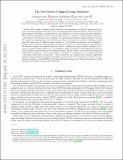The new flavor of Higgsed gauge mediation
Author(s)
Craig, Nathaniel; McCullough, Matthew P.; Thaler, Jesse
DownloadThaler_The New.pdf (656.4Kb)
OPEN_ACCESS_POLICY
Open Access Policy
Creative Commons Attribution-Noncommercial-Share Alike
Terms of use
Metadata
Show full item recordAbstract
Recent LHC bounds on squark masses combined with naturalness and flavor considerations motivate non-trivial sfermion mass spectra in the supersymmetric Standard Model. These can arise if supersymmetry breaking is communicated to the visible sector via new extended gauge symmetries. Such extended symmetries must be spontaneously broken, or confined, complicating the calculation of soft masses. We develop a new formalism for calculating perturbative gauge-mediated two-loop soft masses for gauge groups with arbitrary patterns of spontaneous symmetry breaking, simplifying the framework of “Higgsed gauge mediation.” The resulting expressions can be applied to Abelian and non-Abelian gauge groups, opening new avenues for supersymmetric model building. We present a number of examples using our method, ranging from grand unified threshold corrections in standard gauge mediation to soft masses in gauge extensions of the Higgs sector that can raise the Higgs mass through non-decoupling D-terms. We also outline a new mediation mechanism called “flavor mediation”, where supersymmetry breaking is communicated via a gauged subgroup of Standard Model flavor symmetries. Flavor mediation can automatically generate suppressed masses for third-generation squarks and implies a nearly exact U(2) symmetry in the first two generations, yielding a “natural SUSY” spectrum without imposing ad hoc global symmetries or giving preferential treatment to particular generations.
Date issued
2012-03Department
Massachusetts Institute of Technology. Department of PhysicsJournal
Journal of High Energy Physics
Publisher
Springer Science + Business Media B.V.
Citation
Craig, Nathaniel, Matthew McCullough, and Jesse Thaler. The New Flavor of Higgsed Gauge Mediation. Journal of High Energy Physics 2012, no. 3 (March 15, 2012).
Version: Original manuscript
ISSN
1029-8479